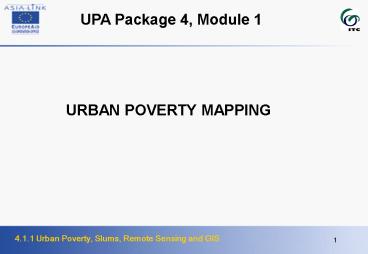URBAN POVERTY MAPPING PowerPoint PPT Presentation
1 / 24
Title: URBAN POVERTY MAPPING
1
UPA Package 4, Module 1
- URBAN POVERTY MAPPING
2
Urban Poverty Mapping
- Module 4.1 Urban Poverty and Data Sources
- Module 4.2 Statistics
- Module 4.3 Geographical Information Systems
- Rationale and Objectives of Educational Package
- Urban Poverty Mapping
3
Urban Poverty Mapping
- Lessons (12)
- Exercises (9) based on Netherlands and Enschede
data - Exercises (3) based on Cebu data
- Self study
- Exam
4
Urban Poverty, Remote Sensing and GIS
- Urban Poverty (package 1), Land (package 2) and
- Settlement Improvement (package 3)
- Slums, Poverty and Inequity
- Remote Sensing, can you see the poor?
- GIS and Urban Poverty Mapping
5
Multi-dimensions of Poverty (Educational Package
1)
6
90of the population growth between 2000 and 2030
will take place in the cities of the developing
world
7
Urban Growth
8
(No Transcript)
9
Access to Land and Security of Tenure
(Educational Package 2)
- Background of insecure tenure (poverty /
invasions AND weak institutional/legal
frameworks) - Importance of (de-facto) security of tenure for
settlement development - Policies, programmes and (project) interventions
- 27 minutes video BBC World Land Rites / Negative
impact of forced evictions
10
Security of Land Tenure
- Security of tenure describes an agreement between
an individual or group on land and residential
property which is governed and regulated by a
legal and administrative framework. The security
derives from the fact that the right of access to
and use of the land and property is underwritten
by a known set of rules, and that this right is
justifiable. The tenure can be effected in a
variety of ways, depending on constitutional and
legal frameworks, social norms, cultural values,
and to some extent, individual preferences
(UNCHS, 1999).
11
Security of Land Tenure
12
Land Management and Poverty Alleviation
- How the poor lose their place in the city
- Urbanization, Informal developments,
displacement, gentrification, resettlement - How the poor regain their place in the city
- Tenure improvement and settlement upgrading
13
Slums, Poverty, Inequity
14
The Urbanization of Poverty
15
Cities without Slums the Inclusive City
- A Dwelling is a Slum if one, or more, of these
criteria are missing - Access to improved water and access to improved
sanitation - Sufficient living area, not overcrowded
- Structural quality / durability of dwellings
- Security of Tenure
16
Slums of the World
17
Slum Trend 1990 - 2001
18
Cities Places for the Rich and the Poor
19
Remote Sensing, can you see the Poor?
- Poverty Line and Living Conditions
Basic Needs Below Poverty Line Above Poverty Line
Unsatisfied Structural Poor Potential Non-Poor
Satisfied New Poor Non-Poor
20
Remote Sensing, can you see the Poor?
- Visible characteristics of slums
- Dwelling size, building material, morphology,
location, density, dispersed or concentrated,
others? - Are slum dwellers socio-economic homogenous?
- Non-visible characteristics of poverty
- New poor, hidden poverty
21
Remote Sensing
- Ground photos / aerial photographs and satellite
images - Technical specifications (spatial resolution)
22
Spatial Resolution
23
Remote Sensing
24
GIS and Urban Poverty Mapping
- Geo-Visualizatio
- Aggregation/dis-aggregation (Addis, Kebeles /
Sub-cities) - Participatory Approach (Nakuru)
- Poverty Mapping Methodologies (World Bank)
- GIS gluing (spatial) data producers,
institutional collaboration - Where are the poor? What can be done?

